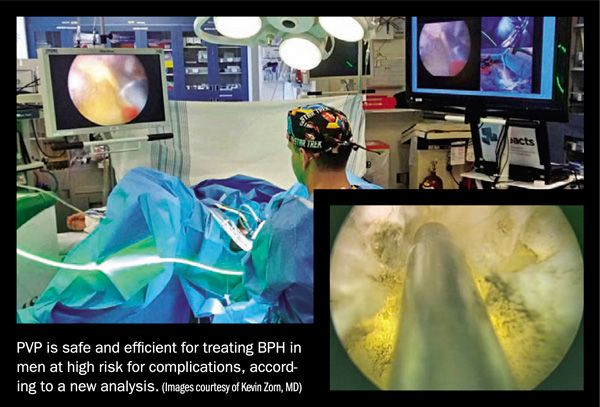Article
Study supports BPH laser’s use in high-risk men
Author(s):
Laser photoselective vaporization prostatectomy using a 180W 532-nm lithium triborate laser (GreenLight XPS-180W laser system, American Medical Systems) is a safe and efficient option for treating BPH in men at high risk for surgical complications, according to findings from a large, international retrospective analysis.

Madrid, Spain-Laser photoselective vaporization prostatectomy (PVP) using a 180W 532-nm lithium triborate laser (GreenLight XPS-180W laser system, American Medical Systems) is a safe and efficient option for treating BPH in men at high risk for surgical complications, according to findings from a large, international retrospective analysis.
READ: BPH technique efficacious even in severe obstruction
As a caveat, however, the authors suggested cases involving a very large prostate (>120 cc) may be best performed in the hands of surgeons with more PVP expertise, as this particular subgroup had a higher conversion rate to transurethral resection of the prostate (TURP).
The study, which was presented at the European Association of Urology annual congress in Madrid, Spain, analyzed data on operative parameters, complications, and efficacy measures from follow-up ranging to 2 years for 1,196 patients who underwent PVP at one of six centers located in Europe, Canada, and the United States. Outcomes for men in subgroups representing patients on anticoagulant therapy with clopidogrel (Plavix) or warfarin (127 patients), age >80 years (176 patients), prostate volume >120 cc by preoperative transurethral ultrasound (143), and in urinary retention with an indwelling catheter for at least 6 months (222) were compared with those for the entire cohort.
NEXT: "The results of this study confirm the safety of laser PVP"

Dr. Zorn“With the population aging, urologists are facing an increasing number of men with BPH who are at higher risk for complications when undergoing conventional surgical intervention,” said senior author and principal investigator Kevin Zorn, MD, assistant professor of urology at the University of Montreal (CHUM), Montreal.
“For all patients with BPH, it is important to select a procedure that will provide maximum improvement in lower urinary tract symptoms and quality of life while minimizing surgery-related complications. The results of this study confirm the safety of laser PVP and may support its choice in high-risk patients.”
Among men with a prostate volume >120 cc, as measured by transrectal ultrasonography, the rate of conversion to TURP was 11%, compared with 3.1% for the overall population. Men on anticoagulant therapy and those aged >80 years had a significantly longer mean hospital stay than the overall population (42 and 40 hours vs. 28 hours), but otherwise had the same low rates of complications as the overall population, said first author Pierre-Alain Hueber, MD, PhD, senior urology resident at the University of Montreal.
“No men on anticoagulant therapy required blood transfusion for a bleeding complication, and postoperative bleeding outcomes were comparable to the reference cohort,” Dr. Hueber reported.
SEE: Study uncovers 400% cost difference in BPH treatments
Compared with the overall population, patients who were in retention with an indwelling catheter had higher rates of bleeding hematuria (15.8% vs. 9.7%) and incontinence (10.3% vs. 4.5%).
“In particular, the increased risk of incontinence should be mentioned preoperatively to patients who are in retention,” he said.
NEXT: IPSS, QoL similar across all groups
IPSS, QoL similar across all groups
Compared to baseline, improvements in the International Prostate Symptom Score and quality of life score were similar across all groups. However, improvement in maximum flow rate (Qmax) was significantly less in patients aged >80 years than in the total population, and the decrease in PSA was less in men with a prostate volume >120cc compared to the overall population.
“The smaller reduction in PSA in men with very large prostates may reflect suboptimal adenoma removal. Longer follow-up is needed to see if the need for retreatment will be higher among men with a very large prostate,” Dr. Hueber said.
Dr. Zorn is a consultant, lecturer, and trainer for American Medical Systems.
You might also like:
Post-RP radiation therapy on decline in U.S.
Embolization shows promise, wide applicability in BPH
Transfusion rate high with prostatectomy for BPH
Subscribe to Urology Times to get monthly news from the leading news source for urologists.
Newsletter
Stay current with the latest urology news and practice-changing insights — sign up now for the essential updates every urologist needs.













